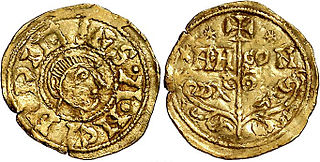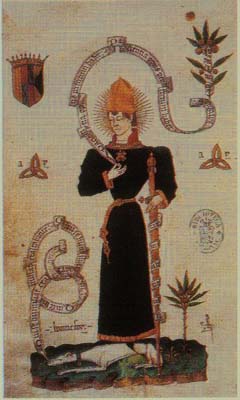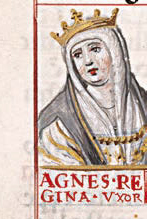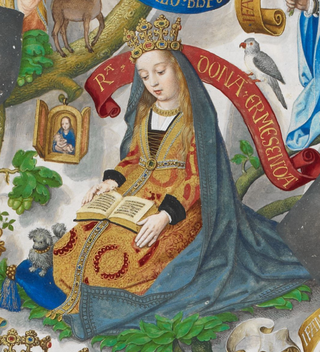See also
- Agnes, wife of Ramiro I of Aragon, (fl. 1054–1062), perhaps of Aquitaine, perhaps identical to the Countess of Savoy
Agnes of Aquitaine may refer to:
Leonora of Castile or Eleanor of Castile may refer to:

Ramiro I was the first King of Aragon from 1035 until his death, although he is sometimes described as a petty king. He would expand the nascent Kingdom of Aragon through his acquisition of territories, such as Sobrarbe and Ribagorza, and the city of Sangüesa. Sancho Ramírez, his son and successor, was King of Aragon, but also became King of Pamplona.

Sancho Ramírez was King of Aragon from 1063 until 1094 and King of Pamplona from 1076 under the name of Sancho V. He was the eldest son of Ramiro I and Ermesinda of Bigorre. His father was the first king of Aragon and an illegitimate son of Sancho III of Pamplona. He inherited the Aragonese crown from his father in 1063. Sancho Ramírez was chosen king of Pamplona by Navarrese noblemen after Sancho IV was murdered by his siblings.

Eleanor is a feminine given name, originally from an Old French adaptation of the Old Provençal name Aliénor. It was the name of a number of women of royalty and nobility in western Europe during the High Middle Ages. The name was introduced to England by Eleanor of Aquitaine, who came to marry King Henry II. It was also borne by Eleanor of Provence, who became Queen consort of England as the wife of King Henry III, and Eleanor of Castile, wife of Edward I.

Charles, Prince of Viana, sometimes called Charles IV of Navarre, was the son of King John II of Aragon and Queen Blanche I of Navarre.

Petronilla, whose name is also spelled Petronila or Petronella, was Queen of Aragon (1137–1164) from the abdication of her father, Ramiro II, in 1137 until her own abdication in 1164. After her abdication she acted as regent during the minority of her son Alfonso II of Aragon (1164–1173). She was the last ruling member of the Jiménez dynasty in Aragon, and by marriage brought the throne to the House of Barcelona.

William VIII, born Guy-Geoffrey (Gui-Geoffroi), was duke of Gascony (1052–1086), and then duke of Aquitaine and count of Poitiers between 1058 and 1086, succeeding his brother William VII (Pierre-Guillaume).
Urraca is a female first name. In Spanish, the name means magpie, derived perhaps from Latin furax, meaning "thievish", in reference to the magpie's tendency to collect shiny items. The name may be of Basque origin, as suggested by onomastic analysis.

García Ramírez, sometimes García IV, V, VI or VII, called the Restorer, was the King of Navarre (Pamplona) from 1134. The election of García Ramírez restored the independence of the Navarrese kingdom after 58 years of political union with the Kingdom of Aragon. After some initial conflict he would align himself with king Alfonso VII of León and Castile, and as his ally take part in the Reconquista.
Agnes of Aquitaine was Queen of Aragon during her brief marriage to King Ramiro II, a former monk. The couple separated after the birth of their only child, Queen Petronilla, and retired to monasteries. Agnes chose the Abbey of Fontevraud, from where she continued to take part in the affairs of her sons from her first marriage to Viscount Aimery V of Thouars.
Countess of Richmond is a title that was given to the wife of the Earl of Richmond. Women who have held the title include:
Agnes of Aquitaine was a daughter of William VIII, Duke of Aquitaine, and his third wife, Hildegarde of Burgundy.
Bertha of Aragon was a Queen consort of Aragon and Navarre. Nothing is known about her childhood or the names of her parents, it is believed that she is Italian since her name was Berta, which is Italian.

Agnes of Aquitaine was a member of the House of Poitou and an Iberian queen in the 11th-century. She was first queen of León, then also of Castile by her marriage to Alfonso VI.
Eleanor or Leanor of Aragon may refer to:
Agnes was a Queen of Aragon, the second wife of Ramiro I of Aragon. She is speculated to have been daughter of either William VI, Duke of Aquitaine or William VII, Duke of Aquitaine, and perhaps remarried to Peter I, Count of Savoy.

Ermesinda of Bigorre, born Gerberga or Gisberga, was a Queen of Aragon, a daughter of Bernard-Roger, Count of Bigorre and his wife Garsenda, Heiress of Bigorre. She was a member of the House of Foix, the sister of Bernard II, Count of Bigorre, Roger I, Count of Foix, and perhaps of Stephanie who married García Sánchez III of Navarre.
Agnes, Queen of Aragon may refer to:
Agnes of Aquitaine was a Countess consort of Savoy and possibly Queen consort of Aragon. She was a daughter of William of Poitou, speculated to be William VII, Duke of Aquitaine, whose wife Ermesinde would then have been her mother.